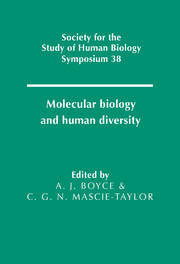Book contents
- Frontmatter
- Contents
- List of contributors
- Preface
- 1 Mitochondrial DNA in ancient and modern humans
- 2 Digital DNA typing of human paternal lineages
- 3 Minisatellites as tools for population genetic analysis
- 4 DNA fingerprinting: development of a technology and its application to the study of human populations
- 5 Kinship, inbreeding, and matching probabilities
- 6 Using the coalescent to interpret gene trees
- 7 Some attempts at measuring natural selection by malaria
- 8 AIDA: Geographical patterns of DNA diversity investigated by autocorrelation statistics
- 9 Mitochondrial DNA sequences in Europe: an insight into population history
- 10 Palaeolithic and neolithic contributions to the European mitochondrial gene pool
- 11 The molecular diversity of the Niokholo Mandenkalu from Eastern Senegal: an insight into West Africa genetic history
- 12 The peopling of Madagascar
- 13 Molecular perspectives on the colonisation of the Pacific
- 14 Population ancestry on Tristan da Cunha–the evidence of the individual
- 15 Linguistic divergence and genetic evolution: a molecular perspective from the New World
- 16 Allelic sequence diversity at the human β-globin locus
- 17 A nuclear perspective on human evolution
- 18 Contrasting gene trees and population trees of the evolution of modern humans
- 19 Methods and models for understanding human diversity
- Index
18 - Contrasting gene trees and population trees of the evolution of modern humans
Published online by Cambridge University Press: 19 September 2009
- Frontmatter
- Contents
- List of contributors
- Preface
- 1 Mitochondrial DNA in ancient and modern humans
- 2 Digital DNA typing of human paternal lineages
- 3 Minisatellites as tools for population genetic analysis
- 4 DNA fingerprinting: development of a technology and its application to the study of human populations
- 5 Kinship, inbreeding, and matching probabilities
- 6 Using the coalescent to interpret gene trees
- 7 Some attempts at measuring natural selection by malaria
- 8 AIDA: Geographical patterns of DNA diversity investigated by autocorrelation statistics
- 9 Mitochondrial DNA sequences in Europe: an insight into population history
- 10 Palaeolithic and neolithic contributions to the European mitochondrial gene pool
- 11 The molecular diversity of the Niokholo Mandenkalu from Eastern Senegal: an insight into West Africa genetic history
- 12 The peopling of Madagascar
- 13 Molecular perspectives on the colonisation of the Pacific
- 14 Population ancestry on Tristan da Cunha–the evidence of the individual
- 15 Linguistic divergence and genetic evolution: a molecular perspective from the New World
- 16 Allelic sequence diversity at the human β-globin locus
- 17 A nuclear perspective on human evolution
- 18 Contrasting gene trees and population trees of the evolution of modern humans
- 19 Methods and models for understanding human diversity
- Index
Summary
A gene tree is an essential descriptor of any evolutionary process, for the semi-conservative replication of the DNA double helix automatically produces a bifurcating gene tree. It should be emphasized that the genealogical relationship of genes is independent of the mutation process, especially when neutral evolution (Kimura, 1983) is considered. The former is a direct product of DNA replication, while the latter may or may not happen within a certain time period and DNA region. Therefore, even if many nucleotide sequences happened to be identical, there must be a genealogical relationship for those sequences. However, it is impossible to reconstruct the genealogical relationship without mutational events. In this respect, extraction of mutations from genes and their products is critical for reconstructing phylogenetic trees.
We can, therefore, best estimate a gene tree according to the mutation events realized on its expected gene tree (see Fig. 18.1 (a)). We call this ideal reconstruction of the gene tree the realized gene tree (see Fig. 18.1 (b)), while the reconstructed one from observed data is called the ‘estimated’ gene tree (Saitou, 1995b). Branch lengths of realized and estimated genes tree are proportional to mutational events. These mutational events are not necessarily proportional to physical time. Because of limitations in information, estimated gene trees are often unrooted.
- Type
- Chapter
- Information
- Molecular Biology and Human Diversity , pp. 265 - 282Publisher: Cambridge University PressPrint publication year: 1996
- 5
- Cited by



